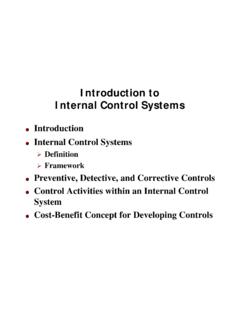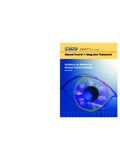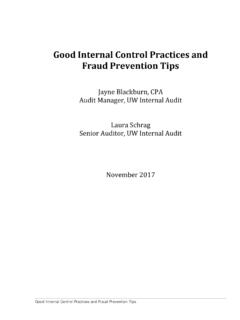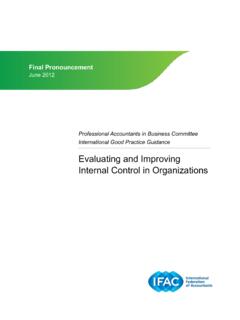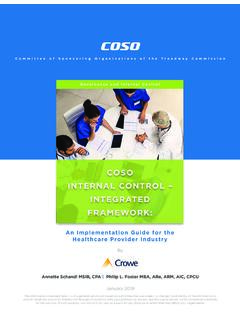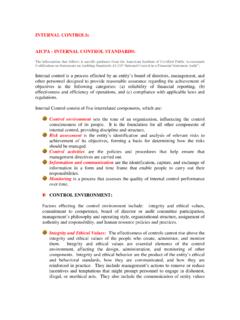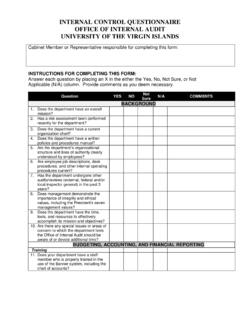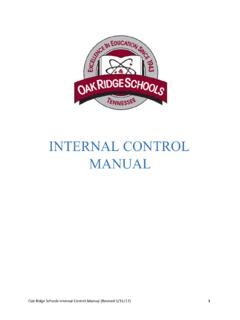Transcription of Framework for internal control systems in banking ...
1 internal control systems1 Framework FOR internal control systems INBANKING ORGANISATIONS(September 1998) part of its on-going efforts to address bank supervisory issues and enhancesupervision through guidance that encourages sound risk management practices, the BasleCommittee on banking Supervision is issuing this Framework for the evaluation of internalcontrol systems . A system of effective internal controls is a critical component of bankmanagement and a foundation for the safe and sound operation of banking organisations. Asystem of strong internal controls can help to ensure that the goals and objectives of a bankingorganisation will be met, that the bank will achieve long-term profitability targets, andmaintain reliable financial and managerial reporting. Such a system can also help to ensurethat the bank will comply with laws and regulations as well as policies, plans, internal rulesand procedures, and decrease the risk of unexpected losses or damage to the bank s paper describes the essential elements of a sound internal control system , drawing uponexperience in member countries and principles established in earlier publications by theCommittee.
2 The objective of the paper is to outline a number of principles for use bysupervisory authorities when evaluating banks internal control Basle Committee, along with banking supervisors throughout the world, hasfocused increasingly on the importance of sound internal controls. This heightened interest ininternal controls is, in part, a result of significant losses incurred by several bankingorganisations. An analysis of the problems related to these losses indicates that they couldprobably have been avoided had the banks maintained effective internal control systems . Suchsystems would have prevented or enabled earlier detection of the problems that led to thelosses, thereby limiting damage to the banking organisation. In developing these principles,the Committee has drawn on lessons learned from problem bank situations in individualmember principles are intended to be of general application and supervisoryauthorities should use them in assessing their own supervisory methods and procedures formonitoring how banks structure their internal control systems .
3 While the exact approachchosen by individual supervisors will depend upon a host of factors, including their on-siteand off-site supervisory techniques and the degree to which external auditors are also used inthe supervisory function, all members of the Basle Committee agree that the principles setout in this paper should be used in evaluating a bank s internal control Basle Committee is distributing this paper to supervisory authoritiesworldwide in the belief that the principles presented will provide a useful Framework for theInternal control systems2effective supervision of internal control systems . More generally, the Committee wishes toemphasise that sound internal controls are essential to the prudent operation of banks and topromoting stability in the financial system as a whole. While the Committee recognises thatnot all institutions may have implemented all aspects of this Framework , banks are workingtowards guidance previously issued by the Basle Committee typically includeddiscussions of internal controls affecting specific areas of bank activities, such as interest raterisk, and trading and derivatives activities.
4 In contrast, this guidance presents a Framework thatthe Basle Committee encourages supervisors to use in evaluating the internal controls over allon- and off-balance sheet activities of banks and consolidated banking organisations. Theguidance does not focus on specific areas or activities within a banking organisation. Theexact application depends on the nature, complexity and risks of the bank s Committee provides background information is section I, sets out theobjectives and role of an internal control Framework in Section II, and stipulates in sections IIIand IV of the paper thirteen principles for banking supervisory authorities to apply inassessing banks internal control systems . In addition, Appendix I lists reference materials andAppendix II provides supervisory lessons learned from past internal control for the Assessment of internal control SystemsManagement oversight and the control culturePrinciple 1:The board of directors should have responsibility for approving and periodicallyreviewing the overall business strategies and significant policies of the bank;understanding the major risks run by the bank, setting acceptable levels for theserisks and ensuring that senior management takes the steps necessary to identify,measure, monitor and control these risks; approving the organisational structure;and ensuring that senior management is monitoring the effectiveness of theinternal control system .
5 The board of directors is ultimately responsible forensuring that an adequate and effective system of internal controls is establishedand 2:Senior management should have responsibility for implementing strategies andpolicies approved by the board; developing processes that identify, measure,monitor and control risks incurred by the bank; maintaining an organisationalInternal control systems3structure that clearly assigns responsibility, authority and reporting relationships;ensuring that delegated responsibilities are effectively carried out; settingappropriate internal control policies; and monitoring the adequacy andeffectiveness of the internal control 3:The board of directors and senior management are responsible for promoting highethical and integrity standards, and for establishing a culture within theorganisation that emphasises and demonstrates to all levels of personnel theimportance of internal controls.
6 All personnel at a banking organisation need tounderstand their role in the internal controls process and be fully engaged in Recognition and AssessmentPrinciple 4:An effective internal control system requires that the material risks that couldadversely affect the achievement of the bank s goals are being recognised andcontinually assessed. This assessment should cover all risks facing the bank andthe consolidated banking organisation (that is, credit risk, country and transferrisk, market risk, interest rate risk, liquidity risk, operational risk, legal risk andreputational risk). internal controls may need to be revised to appropriatelyaddress any new or previously uncontrolled Activities and Segregation of DutiesPrinciple 5: control activities should be an integral part of the daily activities of a bank.
7 Aneffective internal control system requires that an appropriate control structure isset up, with control activities defined at every business level. These should include:top level reviews; appropriate activity controls for different departments ordivisions; physical controls; checking for compliance with exposure limits andfollow-up on non-compliance; a system of approvals and authorisations; and, asystem of verification and 6:An effective internal control system requires that there is appropriate segregationof duties and that personnel are not assigned conflicting responsibilities. Areas ofpotential conflicts of interest should be identified, minimised, and subject tocareful, independent control systems4 Information and communicationPrinciple 7:An effective internal control system requires that there are adequate andcomprehensive internal financial, operational and compliance data, as well asexternal market information about events and conditions that are relevant todecision making.
8 Information should be reliable, timely, accessible, and providedin a consistent 8:An effective internal control system requires that there are reliable informationsystems in place that cover all significant activities of the bank. These systems ,including those that hold and use data in an electronic form, must be secure,monitored independently and supported by adequate contingency 9:An effective internal control system requires effective channels of communicationto ensure that all staff fully understand and adhere to policies and proceduresaffecting their duties and responsibilities and that other relevant information isreaching the appropriate Activities and Correcting DeficienciesPrinciple 10:The overall effectiveness of the bank s internal controls should be monitored on anongoing basis. Monitoring of key risks should be part of the daily activities of thebank as well as periodic evaluations by the business lines and internal 11:There should be an effective and comprehensive internal audit of the internalcontrol system carried out by operationally independent, appropriately trainedand competent staff.
9 The internal audit function, as part of the monitoring of thesystem of internal controls, should report directly to the board of directors or itsaudit committee, and to senior 12: internal control deficiencies, whether identified by business line, internal audit, orother control personnel, should be reported in a timely manner to the appropriatemanagement level and addressed promptly. Material internal control deficienciesshould be reported to senior management and the board of control systems5 Evaluation of internal control systems by Supervisory AuthoritiesPrinciple 13:Supervisors should require that all banks, regardless of size, have an effectivesystem of internal controls that is consistent with the nature, complexity, and riskinherent in their on- and off-balance-sheet activities and that responds to changesin the bank s environment and conditions.
10 In those instances where supervisorsdetermine that a bank's internal control system is not adequate or effective for thatbank s specific risk profile (for example, does not cover all of the principlescontained in this document), they should take appropriate Basle Committee has studied recent banking problems in order to identify themajor sources of internal control deficiencies. The problems identified reinforce theimportance of having bank directors and management, internal and external auditors, and banksupervisors focus more attention on strengthening internal control systems and continuallyevaluating their effectiveness. Several recent cases demonstrate that inadequate internalcontrols can lead to significant losses for types of control breakdowns typically seen in problem bank cases can begrouped into five categories: Lack of adequate management oversight and accountability, and failure to develop astrong control culture within the bank.










